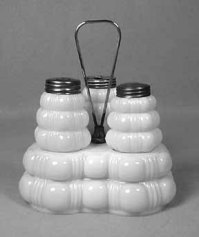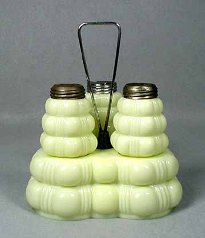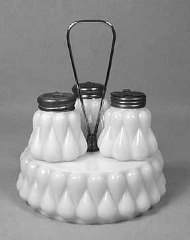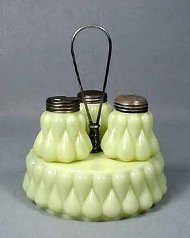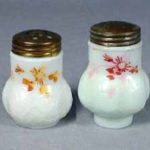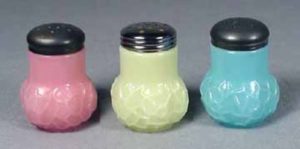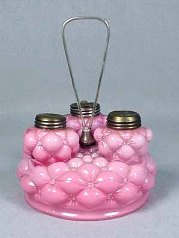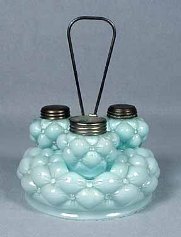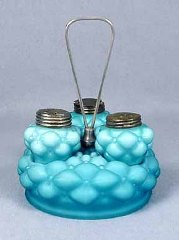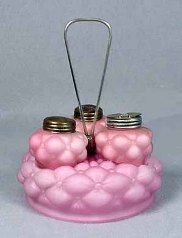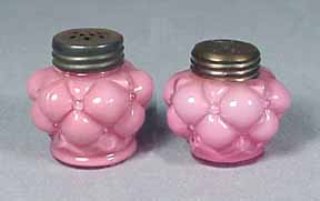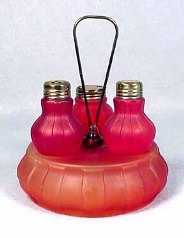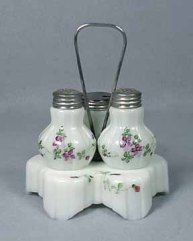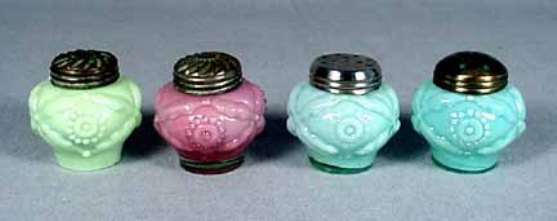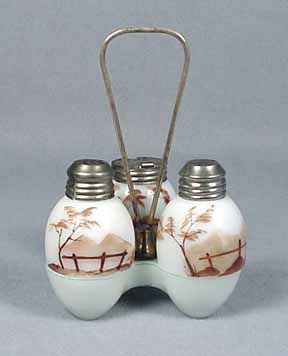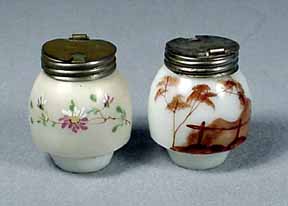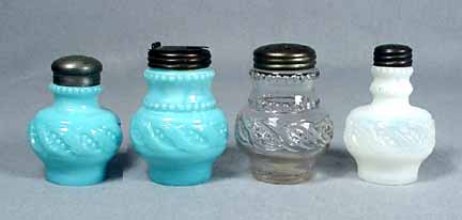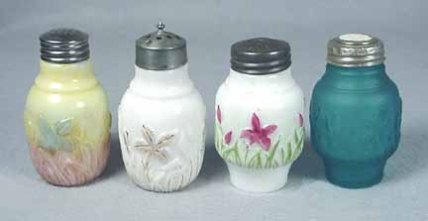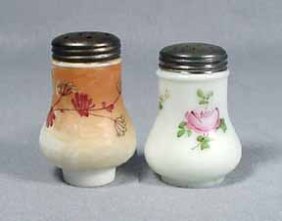Victorian Condiment Sets
Bob and Carole Bruce
The lady of the house often used condiments as the centerpiece for her table in the Victorian era. The glass of this era was beautiful with many different colors and designs to compliment her other table settings. We have been fascinated with the many different patterns of salt shakers for several years and have collected many of the condiment sets. This article will show some of the condiment sets she had at her disposal.
In addition to the more familiar metal holder sets containing several condiment bottles, smaller condiment sets were available. Some were cruet sets consisting of salt, pepper and a vinegar cruet on a glass tray. These sometimes also included a toothpick holder. More frequently found were condiment sets consisting of a salt, pepper and mustard pot, normally on a matching glass base. We have limited this article to sets with glass bases. Most of the sets have matching stand alone salt and pepper shakers. The bases are different in that they are flat without a ring to fit into the condiment base. We show some of these for comparison. At the end of this article we show a table that is our attempt to provide the reader with a guide to collecting these sets.
Two companies, Consolidated Lamp and Glass Company and Dithridge & Sons, made the more popular sets. These two companies were the leaders in producing colored opalware salt and pepper shakers.
The two most commonly found Dithridge condiment sets have been named Creased Bale and Bulging Teardrop by Peterson in his classic books on salt shakers. Attribution to Dithridge of these sets is based upon shakers shown in an 1894 advertisement by Dithridge and Sons. See Peterson, p180. The condiment shakers for these sets were also sold individually as stand alone shakers. These sets are known in White, Pink, Blue, and Custard opalware. It is interesting to note that all 10 of the shakers shown in the advertisement are known in these colors. All of these colors but the pink Creased Bale are homogeneous single layer glass. The pink Creased Bale items are cased glass, consisting of a thin inner layer of white opalware. Several manufacturing firms used cased glass for the pink color to get a lighter softer pink color. On the other hand, the Bulging Teardrop pink sets are a deeper, richer pink color. One author reports that these sets both came in green. Neither of these sets nor any of the shakers in the 1894 advertisement have been reported in green. We suspect that these were both errors. Any color but those shown would be extremely rare.
Creased Bale Condiment Sets
The Creased Bale sets have not been reproduced. Some collectors have feared that they had a reproduction set as the shakers in this pattern were found in two different sizes. Through the years tops have been replaced when they were damaged or lost. The mustard tops were replaced with a salt or pepper top. Since the mustard is shorter than the salt or pepper for this set, it appeared to be from a different set. We have no verification of this, however, the only shorter shakers we have seen have replacement tops whereas sets with an original mustard top have a shorter “shaker” for the mustard. Of course, as sets were pieced together throughout the years, sets can be found with all shakers the same size.
Bulging Teardrop Condiment Sets
Note the darker color of pink for this set compared to the Creased Bale Set.
Fenton reproduced the Bulging Teardrop set in the mid 1950 period in several colors. It is easy to tell the difference. The old shakers are rough on the top where they were broken off the blowpipe and not ground. The newer shakers are thicker glass and the tops have been ground smooth. The shaker tops and the handle for the glass base are chrome plated. In addition, the sets are not the same size. The base of the newer shakers are smaller in diameter, thus the old shakers will not fit in a new base. In fact, shakers in the pattern in clear glass colors are being sold new today.
Dithridge’s Princess Swirl Condiment Sets
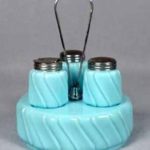
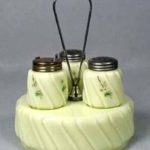 Another Condiment Set that is attributed to Dithridge, but seldom found in a complete set, is called “Princess Swirl”. Unfortunately this name has also been used for another shaker so the Dithridge name should always be used with it. This set first appeared in the literature in Heacock’s Book 4 on Custard Glass. He named it and credited it to Dithridge. We suspect his attribution was based upon the fact that Dithridge made this type of custard shakers and other items whereas Consolidated is not known for making custard colored items. Since Dithridge’s Princess Swirl also comes in the Dithridge colors of pink, blue and white, his attribution certainly is a good bet. The set is also found decorated with small flowers on alternating panels. The pink pieces are cased like the Creased Bale items. The salt, pepper and mustard are all the same size in these sets.
Another Condiment Set that is attributed to Dithridge, but seldom found in a complete set, is called “Princess Swirl”. Unfortunately this name has also been used for another shaker so the Dithridge name should always be used with it. This set first appeared in the literature in Heacock’s Book 4 on Custard Glass. He named it and credited it to Dithridge. We suspect his attribution was based upon the fact that Dithridge made this type of custard shakers and other items whereas Consolidated is not known for making custard colored items. Since Dithridge’s Princess Swirl also comes in the Dithridge colors of pink, blue and white, his attribution certainly is a good bet. The set is also found decorated with small flowers on alternating panels. The pink pieces are cased like the Creased Bale items. The salt, pepper and mustard are all the same size in these sets.
Dithridge Princess Swirl is a confusing pattern. One is referred to the Lechners’ discussion of it in their Books 2 and 3. In summary, this shape is like the Helmschmeid Swirl pattern known to be sold by C.F. Monroe as part of their Wave Crest line. That shaker is known as Erie Twist. We do not know the source of that name. Since it is a patented design, the question comes up as to how Dithridge could sell a set with the same shape. The Lechners in their books on “The World of Salt Shakers”, concluded that Dithridge made the glass for Monroe but reserved rights to sell a similar shaker. While their conclusion is a possibility, it is controversial and only reported here for information.
The pattern is further confusing in that there are two versions of the Dithridge salt. The condiment shakers are larger with a large top. There is a condiment salt and a stand alone salt. The stand alone shakers have a small top and no base to fit into the condiment stand. Further confusing is the fact that Fenton copied the design in the fifties and issued pieces in the pattern. They are slightly larger than the original.
How do we tell the difference between new and old, Monroe and Dithridge? The Monroe shakers are always white opalware, slightly smaller, and require a two piece top. All we have seen are satinized and with an unmistakable Wave Crest decor. The Dithridge shakers have a simple decor when decorated. The Fenton shakers, probably sold initially by L G Wright are bigger in diameter, much heavier glass, and have ground off tops. Some clear cranberry and rubina shakers, some beautifully decorated, have been seen and are likely a later issue.
Alba Condiment Sets
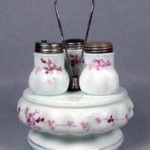 A slightly different glass based condiment set by Dithridge is the Alba Pattern Condiment Set. The base is higher than most others, as it sits upon a pedestal. We have only seen this set in decorated opalware. The decor consists of small flowers.
A slightly different glass based condiment set by Dithridge is the Alba Pattern Condiment Set. The base is higher than most others, as it sits upon a pedestal. We have only seen this set in decorated opalware. The decor consists of small flowers.
Three decorations are known. One, the flowers are multicolored. The other two are all brown flowers or all pink flowers. The Alba shaker made to stand alone does not have the base made to fit into the glass base. The Lechners say the Alba Condiment set was also made in blue, pink, green and custard. We believe they were referring to the non-condiment shakers, which are known in the three colors of Dithridge noted above. Again, green is a Consolidated color and not known for this set. Since this condiment set has been listed as rare for some time, any color would be extremely rare.
Consolidated Lamp and Glass Company produced the majority of these types of condiment sets. They range from the most common to some of the rarest and most desirable.
Bulging Three Petal Condiment Sets
The most common sets are called Bulging Three Petal, again named by Peterson. These are interesting sets since they come in so many colors and glass types. They are available in pink cased, yellow cased, and two types/colors of blue cased glass, and ?. , The shakers and mustards for all of these sets have a thin opal layer with a clear glass outer layer. The pink and yellow sets are cased with clear crystal glass over the primary opalware color. One of the blue sets is also the same, resulting in a soft pastel blue color. However, one of the blue sets has a white opalware liner with clear blue cased glass on the outside. This technique gives a very beautiful dark rich blue color, the photo due not do justice to these sets. All four of these sets are also found in satin glass. That is, the glass has been acid etched to give a dull satin finish, a very popular treatment of this era. The total number of different sets in this pattern is therefore eight. What a job it was to find complete sets of all of these.
However, as soon as we thought we had a complete set, another color showed up at the convention. A dark green, translucent, single shaker was shown by an advanced collector. This shaker created quite a controversy. See comments below.
The Lechners show a bulging three petal condiment salt in their Book 2 in ruby glass or pigeon blood. It is hard to see from the photo, but this shaker has a ring base. Although a condiment set in pigeon blood would be beautiful and an extremely rare find, all of the salts we have seen in this color are not the condiment set version. These stand alone bulging three petal shakers are also known in green opalware, blue opalware, and pink cased.
Attribution of these sets is based primarily upon the very similar shaker known as Bulging Petal shown in the 1894 Consolidated advertisement, Peterson p 179, and the color match to Consolidated’s colors. However, we have not seen a catalog reprint attributing them to Consolidated for positive proof. One author has suggested that these sets have been reproduced, and are possibly not Victorian. What a shame when this information is put forth as authoritative with little or no supporting data. We have seen no evidence of that and no supporting evidence to the claim. We think there could have been some confusion with the known Bulging Teardrop reproductions. All of the sets pictured here have Victorian glass characteristics and show typical expected wear. Some of the sets shown in the accompanying pictures have been in a collection since the late 40s when they were purchased in antique shops at that time, certainly not as new items. A catalog reprint of 1895 shows that they were made then. It is our opinion that they have not been reproduced. If anyone has any supporting data that these shakers could be reproductions. please let us know.
 The green translucent shaker has the characteristics of the other shakers shown. The Lechners’ book III pictures it and calls it a reproduction. However there is no supporting data. Again, we feel it is likely based on the same judgment that called other pieces in this set reproductions. Although no Consolidated shaker is known to be translucent green, there are many cases where one of a kind color or shaker has appeared. So the jury is still out on this one but we cannot wait to find a complete set in this extremely rare color of undoubtedly limited production.
The green translucent shaker has the characteristics of the other shakers shown. The Lechners’ book III pictures it and calls it a reproduction. However there is no supporting data. Again, we feel it is likely based on the same judgment that called other pieces in this set reproductions. Although no Consolidated shaker is known to be translucent green, there are many cases where one of a kind color or shaker has appeared. So the jury is still out on this one but we cannot wait to find a complete set in this extremely rare color of undoubtedly limited production.
When a single item is found that is in an unreported color in a pattern, it is always questioned as to authenticity. It makes one think of the many barrels of known items that were made and how few survived. Then for an item of limited production, how reasonable it is for just a very few to survive and finally surface.
We find it interesting that in the same advertisement seen above, you could buy a dozen eggs for $2.70. Not for cooking, but holding salt or pepper. Yes, Mt Washington eggs for $.25. Three hand decorated eggs for the same price as this condiment set.
We found a Bulging Three Petal set in pink cased with a mini lamp and two toothpicks, instead of the salt, pepper and mustard. Since it was a long time ago, we can now admit it. The toothpicks were shakers with ground off tops. The lamp was a shaker with a lamp top. Toothpick collectors and minilamp collectors need to be aware that there are still unscrupulous dealers trying to make a unique piece for a quick buck. Shaker collectors can sometimes find a nice shaker that has been converted to a minilamp. However, the dealer normally wants more money for it since it is a lamp. To the salt shaker collector it is just buying a shaker without a top.
Cosmos Condiment Set
 Another well known Victorian glass pattern that has a matching condiment set as one of the items made is the very popular Cosmos pattern. It was also made by Consolidated. It is always found in decorated opalware with different colored flowers. The stand alone shakers for this set are considerably different from the condiment salts. They are much taller and were made in decorated opalware, blue, green and cased pink glass. These are the basic colors of all of the salts shown in the 1894 advertisement. In addition, pink opalware is likely. The Lechners report it was made in yellow although they do not show that rare color. If that is correct, it would be very rare.
Another well known Victorian glass pattern that has a matching condiment set as one of the items made is the very popular Cosmos pattern. It was also made by Consolidated. It is always found in decorated opalware with different colored flowers. The stand alone shakers for this set are considerably different from the condiment salts. They are much taller and were made in decorated opalware, blue, green and cased pink glass. These are the basic colors of all of the salts shown in the 1894 advertisement. In addition, pink opalware is likely. The Lechners report it was made in yellow although they do not show that rare color. If that is correct, it would be very rare.
Torquay Condiment Sets
One of the most beautiful and rare Consolidated condiment sets is in the Torquay pattern. Torquay is also a popular Victorian pattern glass. From the pictures, you can see that sets were made in two different shapes.
Although both of these pigeon blood sets are extremely rare, the satin version is the rarest. Note orange color on base of each.
The two larger sets are in what is now called pigeon blood glass. We do not know the origin of this term but it is widely used, and sometimes misused. The glass seems to be a thin lightly colored ruby glass. When pigeon blood glass is viewed through the light it has a unique orange cast to it. It has been said that this Nicholas Kopp created glass was used in railroad lanterns, as it resulted a much brighter light than other red lanterns. Calling it ruby glass may be somewhat controversial, however we have purchased shakers where one is much darker than the other. The darker is considered ruby, the lighter pigeon blood.
The pigeon blood condiment sets are very rare and because of their beauty, collectibles and rarity are the most sought after in this article. Torquay is also known in decorated cobalt. We suspect that a condiment set exists in cobalt but since the condiment sets in general are hard to find, it would be extremely rare. We have never seen a single Torquay shaker nor a single condiment shaker in cobalt blue.
The smaller set is decorated opalware and is a smaller set than the others. Pieces of the Torquay pattern in decorated opalware came in flower decorations and different colors on the stripe. Since the pattern is also known with maroon stripes, light blue stripes and yellow stripes, we would assume condiment sets in these colors could be found.
Beaded Crosstie Condiment Set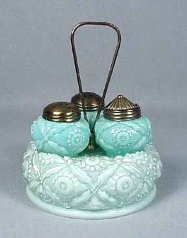
A condiment set that is likely a Northwood product is the Beaded Crosstie set. It is being a little brave to call it Northwood. However, the colors match other Northwood shakers and items. We know of no other maker that has produced the cased green color of the Northwood Cactus Shaker, Flat Flower, Quilted Phlox, Swirl and Leaf, and Crocodile Tears. In addition, the shade of the cased pink color of Beaded Crosstie and those patterns match. We had originally assumed it was Northwood based upon the cased green color and were later excited to find a Beaded Crosstie shaker in the same color and shade of cased pink as some of the other shakers. On the other hand, there is no condiment set with a glass base attributed to Northwood. The set looks much like the sets made by Consolidated. As mentioned above, Beaded Crosstie is also known in cased pink. It is likely that a pink cased condiment set can be found although we have only seen the shaker. Homogenous colors are also known and shakers are all shaped for condiment bases.
Maize Condiment Sets
The Libbey Glass Company made the Maize pattern. The pattern is known in opaque white, a pale yellow color called custard by some collectors, and an iridescent crystal. The condiment set shown is white opalware. Also shown are the shakers for the other types. We could not resist putting the rare iridescent shakers in the opalware base for a photo. To our knowledge a base for the iridescent is not known but will undoubtedly appear. The opalware set is rare and either of the others in a complete set is extremely rare.
Violet Sprig Condiment Sets – AKA Egg Condiment Set
This condiment set was named after the decoration of the third set shown.
It has been more commonly referred to as an Egg Condiment Set, as the set looks like three eggs when the shakers are in the holder. Four different decorations are shown, three on full condiment sets and one on single shaker, a mustard. We have no information on the maker of this set. The shaker shown on the left in the photo of the individual shakers has a satin type finish although it is painted and not satinized. We have seen a total of five decorations in this set and there are likely more.
Bulging Nine Leaf Condiment Sets
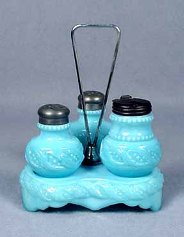
 The Lechners, in their first “World of Salt Shakers” book showed a picture of a white opalware shaker that they named “Bulging Nine Leaf”. They speculated that it was a condiment salt. At a small antique shop we spotted a complete condiment set in blue opalware that we had never seen before. Closer inspection showed it to be the same pattern as Nine Panel Bulging. We had a single shaker in the pattern ( right photo of single shakers below) but it did not match the one the Lechners showed. It also did not match the mustard in the condiment set. We later found a salt and pepper set on a glass base with the same shakers as the condiment set. In our knowledge to date, no other condiment sets in this pattern have been reported. However, since two different sets are known, a different shaped shaker, and a crystal shaker, it would seem that others should appear. One could also suspect this is pattern glass. The maker is unknown. Have you seen one?
The Lechners, in their first “World of Salt Shakers” book showed a picture of a white opalware shaker that they named “Bulging Nine Leaf”. They speculated that it was a condiment salt. At a small antique shop we spotted a complete condiment set in blue opalware that we had never seen before. Closer inspection showed it to be the same pattern as Nine Panel Bulging. We had a single shaker in the pattern ( right photo of single shakers below) but it did not match the one the Lechners showed. It also did not match the mustard in the condiment set. We later found a salt and pepper set on a glass base with the same shakers as the condiment set. In our knowledge to date, no other condiment sets in this pattern have been reported. However, since two different sets are known, a different shaped shaker, and a crystal shaker, it would seem that others should appear. One could also suspect this is pattern glass. The maker is unknown. Have you seen one?
Wild Iris Condiment Sets
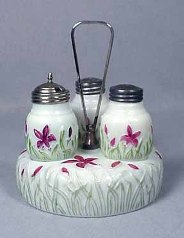
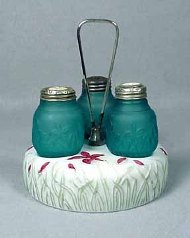 A pattern that has not been attributed to date is called Wild Iris. These sets are found in three decorations on opalware plus a rare unique homogeneous clear satinized blue glass. The opalware decorations found are; an all over pale pink shading to yellow at the top, gold decorated flowers on white, and a decor of maroon and green flowers. The blue glass, sorry we do not have the base in this color, is unique in Victorian glassware. We have not seen nor heard of any Victorian pattern glass in this blue satinized glass. We have seen a small pitcher and a butter base in it, so we know it is pattern glass but we have never seen the condiment base.
A pattern that has not been attributed to date is called Wild Iris. These sets are found in three decorations on opalware plus a rare unique homogeneous clear satinized blue glass. The opalware decorations found are; an all over pale pink shading to yellow at the top, gold decorated flowers on white, and a decor of maroon and green flowers. The blue glass, sorry we do not have the base in this color, is unique in Victorian glassware. We have not seen nor heard of any Victorian pattern glass in this blue satinized glass. We have seen a small pitcher and a butter base in it, so we know it is pattern glass but we have never seen the condiment base.
Fostoria’s Opal Condiment Sets
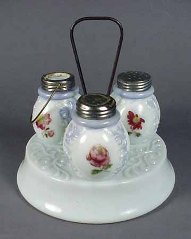
 Another set that is reported in this article for the first time is a Fostoria pattern. The shakers look much like the shakers called Scroll and Bulge. The Scroll and Bulge shakers have been attributed to the Mt. Washington Glass Company by one author, but it is undocumented and many feel it is incorrect. Decorations do not match Mt Washington quality and the shaker is known in blue opalware glass. When we found this set we thought it was the condiment set matching Scroll and Bulge as both designs have three “bulges” separated with scrolling. But an advanced Fostoria collector noted that the scrolls are different. The condiment set is shown in an early 1901 Fostoria catalog.
Another set that is reported in this article for the first time is a Fostoria pattern. The shakers look much like the shakers called Scroll and Bulge. The Scroll and Bulge shakers have been attributed to the Mt. Washington Glass Company by one author, but it is undocumented and many feel it is incorrect. Decorations do not match Mt Washington quality and the shaker is known in blue opalware glass. When we found this set we thought it was the condiment set matching Scroll and Bulge as both designs have three “bulges” separated with scrolling. But an advanced Fostoria collector noted that the scrolls are different. The condiment set is shown in an early 1901 Fostoria catalog.
Flower Sprig Condiment Set, Rose Variation
There are several condiment sets that have not been attributed to any maker. These are decorated white opalware with generic shapes. This condiment set is similar to a set that was named Flower Sprig Condiment Set by the Lechners. The one shown here has roses instead of flower sprigs. The maker of the set is unknown. We are not proposing a name for this set but used the title for identification only.
Fern Condiment Set
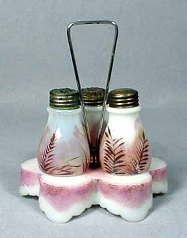 A decorated white opalware condiment set named by the Lechners in their first book, is called Fern Condiment. The decor consists of hand-painted brown ferns over a pink background. The maker of this set is also unknown. The shaker for another decor is shown below. In addition to the shakers matching, the base matches the Fern base.
A decorated white opalware condiment set named by the Lechners in their first book, is called Fern Condiment. The decor consists of hand-painted brown ferns over a pink background. The maker of this set is also unknown. The shaker for another decor is shown below. In addition to the shakers matching, the base matches the Fern base.
Fan Condiment Set

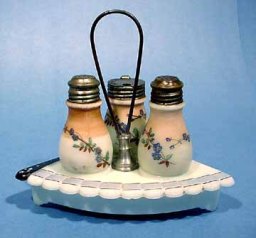 Another opalware decorated condiment set was named Fan by Warman. Attribution to its maker is now known. The Lechners changed the name in their book to Scalloped Fan. (Book II). Thanks to the work of the West Virginia Glass Museum, a rare Dithridge catalog shows this set. OMN, Fan Caster. It has been seen in different decor color combinations.
Another opalware decorated condiment set was named Fan by Warman. Attribution to its maker is now known. The Lechners changed the name in their book to Scalloped Fan. (Book II). Thanks to the work of the West Virginia Glass Museum, a rare Dithridge catalog shows this set. OMN, Fan Caster. It has been seen in different decor color combinations.
Cosmos Scroll Condiment Set
A condiment set that is different than all of the previously discussed sets is called Cosmos Scroll. The differences are that the shakers are much smaller and the base is flat with small indentations for the salt, pepper and mustard. The set is hard to find complete. All are decorated white opalware. There are two or three color combinations that we have seen. One is a pink and green decor and one is a yellow and blue decor. Made by Eagle Glass & Mfg. Co., circa 1898, called their No. 400 Condiment Set.
There are of course more condiment sets to be found from the Victorian era. Several shakers are known which look like they were made to fit into a glass base. An art glass shaker that we were sure belonged in a base like those discussed in this article was just found to be in a small two piece holder just for the salt and pepper. So, one can never be sure until they find the real thing. Plus, if there is one thing we have learned in our collecting experiences, it is that you can never be certain a piece was or was not made by a particular maker. it seems there is always an exception to the rule. Of course, that is part of the excitement we all enjoy.

